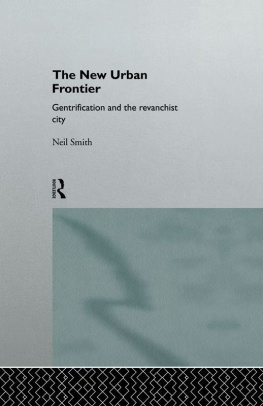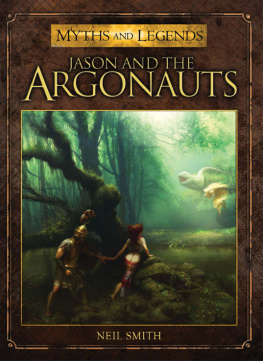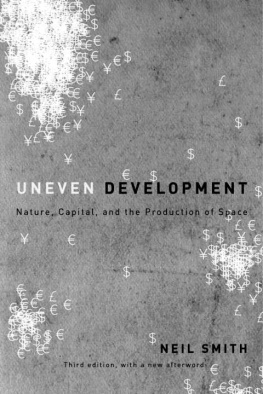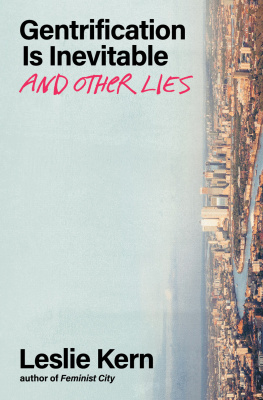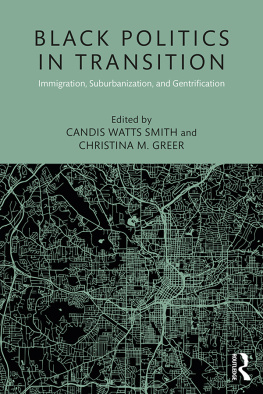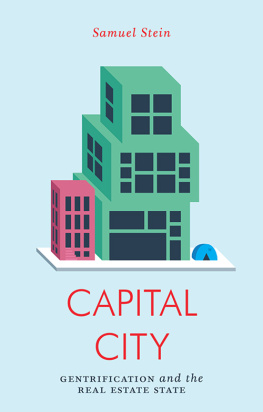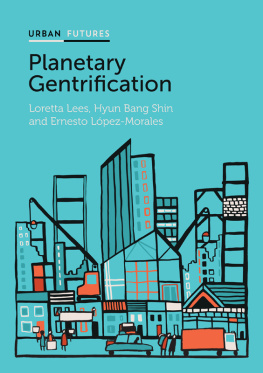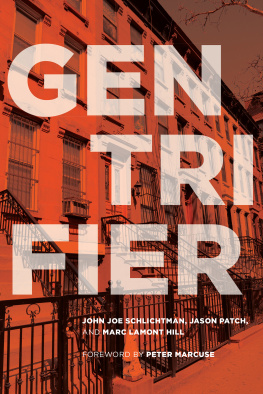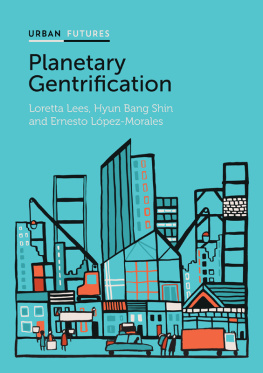Neil Smith - The New Urban Frontier: Gentrification and the Revanchist City
Here you can read online Neil Smith - The New Urban Frontier: Gentrification and the Revanchist City full text of the book (entire story) in english for free. Download pdf and epub, get meaning, cover and reviews about this ebook. year: 1996, publisher: Routledge, genre: Art. Description of the work, (preface) as well as reviews are available. Best literature library LitArk.com created for fans of good reading and offers a wide selection of genres:
Romance novel
Science fiction
Adventure
Detective
Science
History
Home and family
Prose
Art
Politics
Computer
Non-fiction
Religion
Business
Children
Humor
Choose a favorite category and find really read worthwhile books. Enjoy immersion in the world of imagination, feel the emotions of the characters or learn something new for yourself, make an fascinating discovery.
- Book:The New Urban Frontier: Gentrification and the Revanchist City
- Author:
- Publisher:Routledge
- Genre:
- Year:1996
- Rating:5 / 5
- Favourites:Add to favourites
- Your mark:
- 100
- 1
- 2
- 3
- 4
- 5
The New Urban Frontier: Gentrification and the Revanchist City: summary, description and annotation
We offer to read an annotation, description, summary or preface (depends on what the author of the book "The New Urban Frontier: Gentrification and the Revanchist City" wrote himself). If you haven't found the necessary information about the book — write in the comments, we will try to find it.
Neil Smith: author's other books
Who wrote The New Urban Frontier: Gentrification and the Revanchist City? Find out the surname, the name of the author of the book and a list of all author's works by series.
The New Urban Frontier: Gentrification and the Revanchist City — read online for free the complete book (whole text) full work
Below is the text of the book, divided by pages. System saving the place of the last page read, allows you to conveniently read the book "The New Urban Frontier: Gentrification and the Revanchist City" online for free, without having to search again every time where you left off. Put a bookmark, and you can go to the page where you finished reading at any time.
Font size:
Interval:
Bookmark:
THE NEW URBAN FRONTIER
Why have so many central and inner cities in Europe, North America and Australia been so radically revamped in the past three decades, converting urban decay into new chic? Will the process continue in the twenty-first century, or is it ended? What does this mean for the people who live there? Can they do anything about it?
This book challenges conventional wisdomwhich holds gentrification to be the simple outcome of new middle-class tastes and a demand for urban livingto reveal gentrification as part of a much larger shift in the political economy and culture of the late twentieth century. Documenting in gritty detail the conflicts that gentrification brings to the new urban frontiers, the book explores the interconnections of urban policy, patterns of investment, eviction and homelessness.
The failure of liberal urban policy and the end of the 1980s financial boom have made the end-of-the-century city a darker and more dangerous place. Public policy and the private market are conspiring against minorities, working people, the poor and homeless people as never before. In the emerging revanchist city, gentrification has become part of this policy of revenge.
Neil Smith is a Professor of Geography and Acting Director of the Center for the Critical Analysis of Contemporary Culture at Rutgers University.
THE NEW URBAN FRONTIER
Gentrification and the revanchist city
NEIL SMITH

First published 1996 by Routledge 11 New Fetter Lane, London EC4P 4EE
This edition published in the Taylor & Francis e-Library, 2005.
To purchase your own copy of this or any of Taylor & Francis or Routledges collection of thousands of eBooks please go to http://www.ebookstore.tandf.co.uk/.
Simultaneously published in the USA and Canada by Routledge 29 West 35th Street, New York, NY 10001
1996 Neil Smith
All rights reserved. No part of this book may be reprinted or reproduced or utilized in any form or by any electronic, mechanical, or other means, now known or hereafter invented, including photocopying and recording, or in any information storage or retrieval system, without permission in writing from the publishers.
British Library Cataloguing in Publication Data A catalogue record for this book is available from the British Library
Library of Congress Cataloguing in Publication Data Smith, Neil. The new urban frontier: gentrification and the revanchist city/ Neil Smith. p. cm. Includes bibliographical references and index. 1. Gentrification. 2. GentrificationGovernment policy. 3. Urban renewal. 4. Urban policy. I. Title. HT170.S55 1996 307.76-dc20 95-46015
ISBN 0203975642 Master e-book ISBN
ISBN 0415132541 (hbk)
041513255X (pbk)
For Nancy and Ron Smith
CONTENTS
PLATES
FIGURES
TABLES
Preface
In his paradigmatic essay The significance of the frontier in American history, written in 1893, Frederick Jackson Turner (1958 edn.) proposed that:
American development has exhibited not merely advance along a single line but a return to primitive conditions on a continually advancing frontier line, and a new development for that area. American social development has been continually beginning over again on the frontier. In this advance the frontier is the outer edge of the wavethe meeting point between savagery and civilization. The wilderness has been interpenetrated by lines of civilization growing ever more numerous.
For Turner, the expansion of the frontier and the rolling back of wilderness and savagery were an attempt to make livable space out of an unruly and uncooperative nature. This involved not simply a process of spatial expansion and the progressive taming of the physical world. The development of the frontier certainly accomplished these things, but for Turner it was also the central experience which defined the uniqueness of the American national character. With each expansion of the outer edge by robust pioneers, not only were new lands added to the American estate but new blood was added to the veins of the American democratic ideal. Each new wave westward, in the conquest of nature, sent shock waves back east in the democratization of human nature.
During the latter part of the twentieth century the imagery of wilderness and frontier has been applied less to the plains, mountains and forests of the Westnow handsomely civilizedand more to US cities back East. As part of the experience of postwar suburbanization, the US city came to be seen as an urban wilderness; it was, and for many still is, the habitat of disease and disorder, crime and corruption, drugs and danger (Warner 1972). Indeed these were the central fears expressed throughout the 1950s and 1960s by urban theorists who focused on blight and decline, social malaise in the inner city, the pathology of urban lifein short, the unheavenly city (Banfield 1968). The city was rendered a wilderness, or worse, a jungle (Long 1971; Sternlieb 1971; also Castells 1976). More vividly even than in the news media or social science narratives, this became the theme of a whole genre of Hollywood urban jungle movies, from King Kong and West Side Story to The Warriors and Fort Apache, the Bronx. This discourse of decline, as Robert Beauregard (1993) has put it, dominated the treatment of the city.
Antiurbanism has been a central theme in US culture. In a pattern analogous to the original experience of wilderness, the last three decades have seen a shift from fear to romanticism and a progression of urban imagery from wilderness to frontier. Cotton Mather and the Puritans of seventeenth-century New England feared the forest as an impenetrable evil, a dangerous wilderness, a primeval place. But with the continual taming of the forest and its transformation at the hands of increasingly capitalized human labor, the softer imagery of Turners frontier became an obvious successor to Mathers forest of evil. There is an optimism and an expansive expectation associated with the frontier which refracts a sense of self-confident conquest. Thus in the twentieth-century US city, the imagery of urban wildernessa desperate relinquishing of hopewas beginning, by the 1960s (widespread uprisings notwithstanding), to be replaced by a vision of the urban frontier. This transformation can be traced in part to the discourse of urban renewal (Abrams 1965), but was intensified in the 1970s and 1980s as the rehabilitation of single-family homes and tenement blocks became increasingly symbolic of a successor form of urban renewal. In the language of gentrification, the appeal to frontier imagery has been exact: urban pioneers, urban homesteaders and urban cowboys became the new folk heroes of the urban frontier. In the 1980s, the real estate magazines even talked about urban scouts whose job it was to scout out the flanks of gentrifying neighborhoods, check the landscape for profitable reinvestment, and, at the same time, to report home about how friendly the natives were. Less optimistic commentators indict the emergence of a new group of urban outlaws in connection with inner-city drug cultures.
Just as Turner recognized the existence of Native Americans but included them as part of his savage wilderness, contemporary urban frontier imagery treats the present innercity population as a natural element of their physical surroundings. The term urban pioneer is therefore as arrogant as the original notion of pioneers in that it suggests a city not yet socially inhabited; like Native Americans, the urban working class is seen as less than social, a part of the physical environment. Turner was explicit about this when he called the frontier the meeting point between savagery and civilization, and although the 1970s and 1980s frontier vocabulary of gentrification is rarely as explicit, it treats the inner-city population in much the same way (Stratton 1977).
Next pageFont size:
Interval:
Bookmark:
Similar books «The New Urban Frontier: Gentrification and the Revanchist City»
Look at similar books to The New Urban Frontier: Gentrification and the Revanchist City. We have selected literature similar in name and meaning in the hope of providing readers with more options to find new, interesting, not yet read works.
Discussion, reviews of the book The New Urban Frontier: Gentrification and the Revanchist City and just readers' own opinions. Leave your comments, write what you think about the work, its meaning or the main characters. Specify what exactly you liked and what you didn't like, and why you think so.

